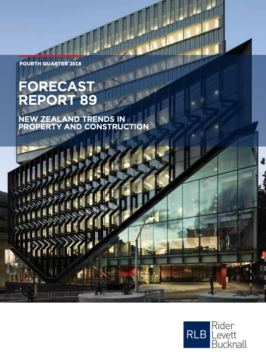The Rider Levett Bucknall (RLB) Forecast 89 Report – New Zealand Trends in Property and Construction – released today confirms construction activity picked up over the second half of 2018, reflecting increased activity across the residential, commercial and government sectors. The increases partly reversed the declines in the previous half, as capacity and financing constraints had hampered construction activity.
Prepared by the New Zealand Institute of Economic Research (Inc.) (NZIER) exclusively for Rider Levett Bucknall (RLB), Forecast 89 shows underlying construction demand remains very strong, reflecting the effects of the population surge in recent years.
Net migration slows as permanent departures increase
Grant Watkins, Director of RLB in Wellington said, ‘Net migration has slowed over the past year. The number of people moving into the country continues to ease, while the number of people leaving New Zealand continues to pick up. Part of this lift in permanent departures reflects people on temporary work and student visas returning to their home countries as the tenure of their visa ends.’
He added, ‘The decline in the number of people moving to New Zealand on student and permanent residency visas since 2016 is in contrast to the continued growth in the number of work visas. This is driven by an increased number of technicians and trade workers moving into the country due to the strong demand in the construction sector.’
KiwiBuild gets off to a slow start
Underlying construction demand remains strong, particularly for residential housing. The government’s KiwiBuild plan to build 100,000 dwellings over the coming decade got off to a slow start, with growth hampered by capacity constraints.
The government expects 1,000 dwellings to be built this year, and for this to ramp up to around 12,000 dwellings per year from 2020. To an extent, the KiwiBuild plan involves the government buying off the plan developments already underway, which is likely to bring forward projects which otherwise may have taken longer to source financing.
Residential housing shifts towards apartments and townhouses
Grant continued, ‘Growth in residential housing continues to shift towards multi-unit dwellings such as apartments and townhouses, while demand for stand-alone houses eases. RLB expects further intensification of housing, given the focus on making the most effective use of available land.’
Despite this, the construction sector continues to face many challenges to this intensification, including low operating margins, labour shortages and uncertainty of cash flow, particularly among smaller and mid-sized firms.
Given the reluctance of major construction companies such as Fletcher Building to engage in further ‘vertical construction’ work, there remains uncertainty over which construction companies will have a sufficiently large balance sheet to lead the construction of larger developments in private and public sectors.
New retail outlets drive growth in non-residential
The RLB report stated that demand for new retail outlets was the top driver of growth in non-residential construction demand over the past year, led by Auckland and the Bay of Plenty. Demand for industrial, farm and storage buildings also grew strongly. The recovery in global commodity prices have meant an improvement in on-farm profitability, with farmers feeling confident enough about the sustainability of this income to start looking towards investment.
Auckland continues to lead construction growth
Grant concluded, ‘Demand for industrial and storage buildings also grew strongly in Auckland over the past year. The effects of strong population growth in Auckland has spilled over to neighbouring regions, with non-residential construction demand growing strongly in Waikato and Bay of Plenty. This growth has been driven by increased demand for healthcare facilities and farm buildings in Waikato, and retail and office buildings in the Bay of Plenty.’
RLB New Zealand Trends in Property and Construction Q4 2018
Prepared by the New Zealand Institute of Economic Research (Inc.) (NZIER) exclusively for RLB, Forecast 88 confirms construction activity eased across the residential, commercial and government sectors over the first quarter of 2018.
FURTHER INFORMATION:



